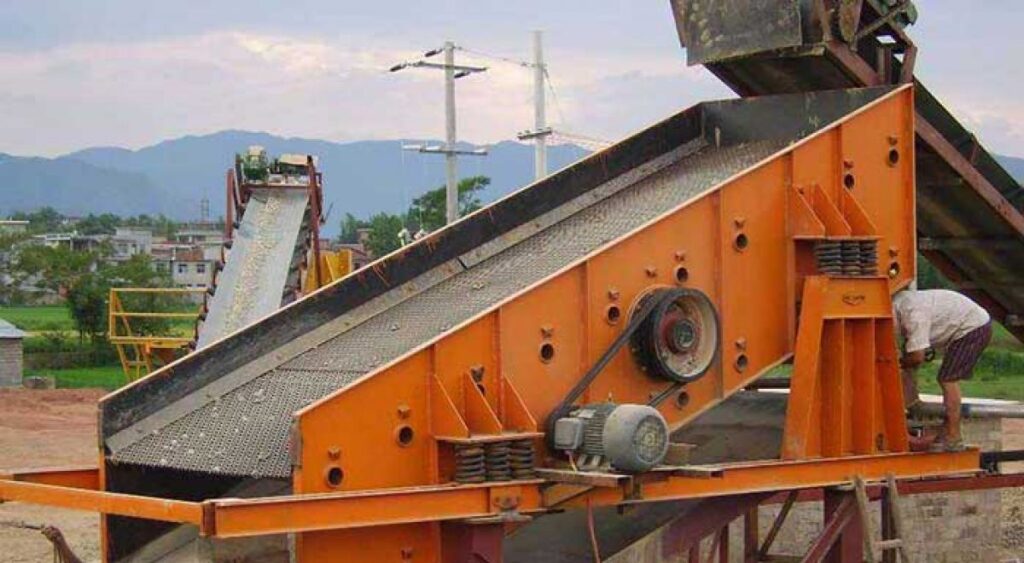Vibrating screens are important equipment used for the separation of different materials in various industries such as mining, construction, chemical, and food processing. There are two main types of vibrating screens: circular and linear. The main difference between these two types is the motion of the screens. In this article, we will discuss the difference between circular and linear vibrating screens, their working principles, applications, and advantages.
What are the types of vibration screens?
There are several types of vibration screens used in construction and recycling. These screens are designed to separate various kinds of materials based on their sizes, densities, or consistencies. They typically use mechanical forces to move the materials through the screen and break them into smaller pieces. Some examples of these materials include small rocks, gravel, dirt, and sand. Other types of vibration screens can be used to separate larger materials like concrete and asphalt.
These screens typically use vibrating motors to shake the larger materials up and down in order to fracture them into smaller pieces. The vibrations created by these motors cause the material to break apart into finer particles. Finally, some types of vibration screens are used in recycling centers to sift through different waste materials. These screens use high-speed movement mechanics to push the materials through the screen and collect them at the other end. They are useful for separating different types of waste, such as paper, plastic, and metals.
Circular Vibrating Screen:
A circular vibrating screen is also called a circular motion vibrating screen. A motor drives the entire screen frame, and the eccentric shaft creates a circular motion. The circular motion enables the material to be separated and screened efficiently. The circular vibrating screen is suitable for screening materials with a particle size of 3mm-150mm. It is widely used in mining, construction, chemical, and food processing industries.
Linear Vibratory Screen:
A linear vibrating screen is also called a linear vibratory screen or a linear vibrating screener. It is a piece of screening equipment for separating materials with a particle size of 0.074-1.5mm. The liner vibration screen has a unique structure, and the screen mesh is made of stainless steel. The linear motion of the screen is created by two counter-rotating unbalance motors. The material on the screen is moved in a straight line, and the screening efficiency is high. The linear vibrating screener is widely used in mining, coal, smelting, building materials, refractory materials, light industry, and chemical industries.
Difference Between Circular and Linear vibratory screen:
- Motion: The main difference between circular and linear vibrating screening equipment is their motion. The circular vibrating screen generates a circular motion, while the linear vibrating screen generates a linear motion.
- Design: Circular vibrating screens typically have a single layer of screens, while linear vibrating screens often have multiple layers of screens. This allows linear screens to offer a larger screening area and handle higher volumes of material.
- Screen Surface: Circular vibrating screens have a smooth surface, while linear vibrating screens have a more rugged surface. This can affect the way materials interact with the screen surface and how efficiently they are sorted and separated.
- Speed: Linear vibrating screens can operate at higher speeds than circular vibrating screens. This means they can handle higher volumes of material and work more efficiently in high-capacity screening applications.
Applications of Circular and Linear Vibrating Screens
Circular vibrating screens are commonly used in the mining industry for sorting and separating materials, such as minerals, coal, and aggregates. They are also used in food processing and chemical industries for sorting and grading powders and granules.
Linear vibrating screens are used in a variety of industries for high-capacity screening of large quantities of material. They are commonly found in mineral processing, coal preparation, and chemical industries, as well as in the food and pharmaceutical industries for sorting and grading powders and granules.
How do I choose a vibrating screen?
Choosing a circular or linear vibrating screen can be difficult as each has advantages and disadvantages. It is important to consider the type of material being screened, the size of the particles to be separated, and the application of the screens. A circular vibrating screen is generally used for large particles or materials with a high density, such as clay, concrete, or sand. On the other hand, a linear vibrating screen is typically used for small particles or materials with low densities, such as pulp, paper, or grain.
Besides, it is crucial to consider the application of the vibrating screens. A linear vibrating screen may be suitable if the application requires high throughput and accuracy, offering greater precision and control. In contrast, a circular vibrating screen may be ideal if a more gentle approach and greater ease of operation are needed.
Eventually, consider the cost and availability of each type of vibrating screen. Circular screens are typically more expensive than linear ones but are generally easier to find in local hardware stores or online retailers. So it’s worth shopping around to find the best price for your particular needs.
Please let us know if you have any questions or would like more information on these types of screens. One thing we can say for sure is that choosing the right vibrating screen for your needs will help ensure optimal performance and productivity. So don’t hesitate to reach out if you need help deciding on the best fit for your needs!
Conclusion
Circular and linear vibrating screens are two commonly used types of vibrating screens in various industries. At the same time, two kinds of screens are designed to efficiently sort and separate materials; they differ in motion, design, screen surface, and speed. Circular vibrating screens are ideal for sorting and separating materials in the mining and construction industries. In contrast, linear vibrating screens are better suited for high-capacity screening applications in mineral processing, coal preparation, and chemical industries.

